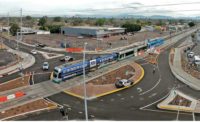With the rebirth and expansion of light-rail service in the Salt Lake Valley, a warehouse that once housed fur coats for high-end retailers has been converted into a maintenance and storage barn for new trains.
The 300,000-sq-ft building, which will include office space as well as a 120,000-sq-ft maintenance facility, sits on 24 acres west of Interstate 15 adjacent to the Jordan River. The current TRAX light-rail system services downtown Salt Lake City and reaches south to the city of Sandy as well as east to the University of Utah and west to the Salt Lake City Intermodal Hub.
The location of the new Jordan Service Center is critical to UTA’s Front Lines program launched in 2006, which will add 70 new miles of light and commuter rail to the UTA system by 2015.
MASONRY SHELL
Mike Tenney, project superintendent for general contractor Ascent Construction, Centerville, Utah, says the transformation of the building from a 1975 retail warehouse to the current light-rail maintenance facility has been dramatic.
“When we got here, there were things like a climate-controlled room where they stored fur coats, a conveyor system and a cafeteria for employees,” Tenney says. “There was an area where people could pick up things they had ordered in the department stores. I remember coming here with my mother when I was a kid.”
Creating entrances and exits for the trains meant cutting out large sections of the masonry shear walls. Salt Lake City-based Reaveley Engineers & Associates helped develop a structural plan for reinforcing the remaining portions of the walls. Tenney says the plan called for drilling 30,000 holes in the masonry to hold epoxy and bolts attached to a rebar mat on the interior, which was then covered with shotcrete.
“The process took about three months. Then we had to come in and remove the existing footings and put new ones in place,” he adds. The floor had to be strong enough to hold 93,000-lb rail cars on each of the seven service tracks that run through the center.
Tenney says a unique feature of the service center is the drop table, a 10-ft-deep service pit equipped to remove the undercarriage of a train from its body. The undercarriage can then be conveyed through a newly carved 80-ft-long, 20-ft-wide tunnel under the floor and lifted to the shop area, where it can be serviced without mechanics having to climb under or on top of the 14-ft-tall trains.
Several bays are equipped with high mezzanines and fall-prevention railings that allow work to occur on top of a vehicle without the need for safety restraints.
“The stars just lined up for all this to happen,” says Todd Provost, program manager for systems at the Utah Transit Authority, who is overseeing the testing and commissioning of the new $40-million service center. “The building is central to our system. It was along our new West Valley corridor and it was for sale.”
Both the West Valley and Mid-Jordan lines are scheduled to open in August, and Provost says the new service center must be fully functional by then.
Article toolbar

Post a comment to this article
Report Abusive Comment